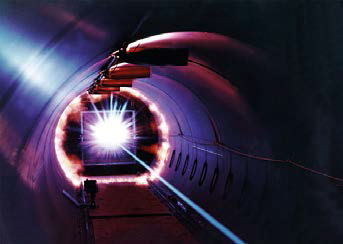A laser generates a temporally and spatially coherent beam (in the same phase of the wave) which implies a small beam in a narrow spectral range. At present there are many types of lasers for an infinite number of applications:
- Class 1: Insurance in reasonable conditions of use. Applications in consumer electronics, IT, scientific research, medicine, industry, military
- Class 1M: Similar to Class 1 but not safe when viewed through optical instruments such as magnifying glasses or binoculars. CD, DVD, Blu-ray
- Class 2: Visible lasers (400 to 700 nm). Aversion reflexes protect the eye even when used with optical instruments. Cut, burn, sublimate materials to mark metals, plastics, glass, printers,...
- Class 2M: As Class 2, but not safe when using optical instruments. Surgical treatments, wound healing, kidney stones, eye surgery, dentistry.
- Class 3R: Lasers whose direct vision is potentially dangerous but the risk is lower and needs fewer manufacturing requirements and control measures than Class 3B. Accurate distance measurement
- Class 3B: Direct vision of the beam is always dangerous, while diffuse reflection is normally safe. missile guidance
- Class 4: Direct exposure to eyes and skin is always dangerous and diffuse reflection is usually too. They can cause fires and explosions. Barcode readers, thermometers, holograms, lighting, acne, cellulite, hair removal,... Regarding types of lasers, we can divide them into three categories:
- Semiconductors: laser diodes. pn junction similar to leds
- Gas: helium-neon, carbon dioxide, nitrogen,…
- Solid state: they use glass, crystals or doped fibers as the active medium. Neodymium-YAG, erbium, thulium, holmium, ruby, sapphire, Alexandrite.
- Dyes or liquids: organic dyes such as Rodamia 6G. With MEAN WELL we offer a wide range of products for customers who manufacture their own laser drivers as shown in table 1. But the comprehensive solution for all these types of applications that we have reviewed would be given by the use of a power supply + laser driver + laser diode. This new product with switched technology has an efficiency of 96% compared to 60% of most drivers with a much more compact size with a power density of 44W/in³. The LDPC-50A driver works with a dynamically adjustable output current from 0 to 50A and a maximum power of 2750W. Although the characteristics that make it really essential are:
- 2μs rise time
- Patented current hysteresis control
- It allows to reduce the process time for a finer and more balanced finish on the material (smoother) • Minimum overshoot (over-shot)
- Output pulses at high speeds, up to 5kHz
- Overshoot <5%
- Ripple current < 1 A rms
- Continuous Wave (CW) Mode
- stable output current
- Cutting, drilling, welding applications
- pulsating mode
- High current pulse operation
- Marking applications, printing
- Slow boil mode (Simmer)
- Sets the maximum and minimum current level
- Rise or ramp time can be adjusted
- Reduces stress on lasers
- Increases stability and life time From Olfer Electronics we are at your disposal to expand as much information as you deem appropriate and to advise you with the best solutions in your laser applications. Be sure to visit us at www.olfer.com





